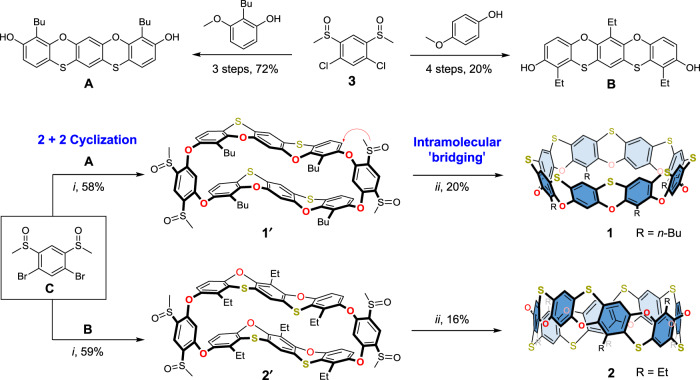Abstract
Hoop-shaped or belt-like molecules have been fascinating not only due to their challenging synthesis, but also unique physical and chemical properties. The incorporation of heteroatoms (N, O, S, etc.) into these belts could alter both molecular structures and electronic properties which will lead to versatile applications, from advanced host-guest systems to functional materials. Despite numerous computational studies, the synthesis and characterization of heteroatom-bridged double-stranded molecular belts remains scarce. Here we report the synthesis, crystal structure, and host-guest chemistry of two novel heteroatom-bridged belt-like macrocycles composed of phenoxathiin. The bowl-shaped belt demonstrates a strong binding affinity (Ka = 3.6 × 109 M‒2) towards fullerene C60 and forms a 2:1 capsule-like complex with the aid of C‒H···S hydrogen bonds. The column-like belt can bind the cyclic guest [2,2]paracyclophane to form a ring-in-ring complex. The modular synthesis, structural specificity, and diverse host-guest chemistry of cyclophenoxathiins markedly expands the known chemistry of molecular belts.
Subject terms: Organic chemistry, Supramolecular chemistry
Heteroatom-bearing molecular loops and belts are fascinating but generally difficult to synthesize. Here, the authors demonstrate that O,S-bridged double-stranded molecular belts—cyclophenoxathiins—can be successfully constructed and employed as versatile supramolecular hosts.
Introduction
Macrocyclic molecules capable of host–guest complexation have been central to the development of modern supramolecular chemistry1. A number of well-established families of synthetic macrocycles, including calixarenes2, calixpyrroles3, resorcinarenes4, pillararenes5, coronarenes6, cyclophanes7, and cycloparaphenylenes (CPPs)8, have found applications in the fabrication of diverse supramolecular architectures, and have led to advanced systems for sensing9, adsorption/separation10, drug delivery11, and molecular machines12. These macrocycles are singly bridged entities—those with repeating units linked via a single-bond bridge.
Recently, double-stranded belt-like macrocycles have attracted significant attention due to their molecular topologies13. For example, the cyclization of subunits with double linkages has been shown to result in molecular belts or Möbius strips14, and the synthesis of all carbon nanobelts could ultimately enable the bottom-up synthesis of carbon nanotubes15. Moreover, belt-like macrocycles can behave as exceptional supramolecular hosts due to their rigid cavities and highly organized internal chemical functionalities. For instance, the intramolecular bridging of resorcinarenes produces cavitands that can be converted into molecular containers and capsules16. However, double-stranded belt-like macrocycles are generally difficult to synthesize, especially for highly strained derivatives such as cyclacenes and their analogs13,17. One feasible synthetic approach for constructing double-stranded belt-like macrocycles involves the post-synthetic transformation of a singly bridged macrocycle by adding additional chemical bridges. This strategy has been successfully applied to construct cavitands16, chrysaoroles18, Möbius strips14, carbon nanobelts15, and, more recently, belt[4]arene[4]tropilidenes19. Despite the numerous theoretical studies20, there are few reported belt-like macrocycles with double-heteroatom bridges that are constructed via this synthetic method21,22. In contrast, this strategy has been successfully applied to synthesis of polymers, including the phenoxathiin-based polyheteroacenes23.
Considering the bent structural feature of phenoxathiin24, we envision a new class of heteroatom-bridged double-stranded belt-like macrocycles that contain the repeating subunit of phenoxathiin (Fig. 1c). The proposed macrocycle could be thought of as a fused product of oxocalixarenes2,25 and thiacalixarenes2,26 and defined as cyclo[n]phenoxathiins (n represents the total number of the phenylenes present in the skeleton of the macrocycle). The highlights of this design include (i) the bent and foldable structure of phenoxathiin (puckering angle ca. 148° and inversion barrier of 1.26 kcal mol−1)24 allows access to less-strained belt-like macrocycles associated with rigid yet dynamic character to accommodate the adaptive binding of guests, (ii) the electron-donating O- and S-atom linkages not only alter the electronic properties of the macrocycle, but also provide extra interaction sites for hydrogen bonding, and (iii) the alternating bridging sequences of O and S can result in various macrocyclic architectures and nanospaces for diverse host–guest complexation. Herein, we report the first synthesis, structures, and host–guest chemistry of two unique doubly bridged belt-like macrocycles, i.e., cyclo[8]phenoxathiins.
Fig. 1. The design of heteroatom-bridged molecular belts.
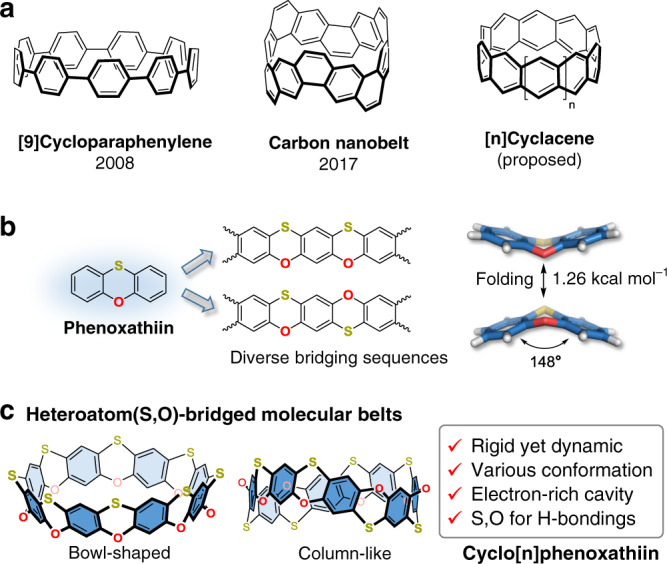
a Example of singly bridged macrocycle ([9]cycloparaphenylene), double-stranded molecular belt (carbon nanobelt), and the proposed structure of cyclacenes. b The features of phenoxathiin as a building block for constructing molecular belts. c The heteroatom(S,O)-bridged molecular belts (cyclo[8]phenoxathiins) report in this work.
Results
Synthesis and characterization
A cyclization-followed-by-bridging strategy was adopted to construct cyclo[8]phenoxathiins. This stepwise synthesis allowed us to precisely control the linking sequences of bridging atoms and, consequently, the conformation of the macrocycle. As outlined in Fig. 2, the key steps of the synthesis include a 2 + 2 Ullmann-type coupling cyclization and the subsequent intramolecular Friedel–Crafts reaction with the generated sulfonium cation. The phenoxathiin-derived biphenolic building block A can be obtained from monomethylated 2-buylresorcinol and 3 in three steps with a combined yield of 72% (see Supplementary Methods). The butyl groups not only aid the solubility of the final macrocycle, but also eliminate the regioselectivity during the bridging reaction. Replacing the resorcinol with p-methoxyphenol during the synthesis provided building block B (4 steps, 20%, see Supplementary Methods), which ultimately altered the conformation of the macrocycle formed via 1,4-oxophenylenes. Cyclization of building block A or B with dibromo C afforded the sulfinyl oxo-bridged macrocyclic precursor 1′ or 2′ with moderate yields (58% and 59%). Finally, cyclo[8]phenoxathiins 1 and 2 were successfully obtained by carrying out the intramolecular bridging reaction under acidic conditions. Both 1 and 2 were fully characterized by NMR, mass spectrometry, and single-crystal X-ray diffraction analysis.
Fig. 2. Syntheses of cyclo[8]phenoxathiins 1 and 2 through a cyclization-followed-by-bridging strategy.
Conditions: (i) Cs2CO3, CuI, N,N-dimethylglycine, N,N-dimethylacetamide, 150 °C for 48 h; (ii) CF3SO3H, 80 °C for 48 h, then pyridine/H2O, 105 °C for 15 h. Substituent groups: n-Bu n-butyl, Et ethyl.
Single crystals of 1 were obtained by slow diffusion of ethanol into a nitrobenzene solution of 1. X-ray crystallography reveals that 1 adopts a bowl-shaped structure that is similar to the structure of cyclodextrins (Fig. 3a, b). Uniquely and as-designed, all eight S atoms are located on the same side of the belt forming the upper rim with a diameter of 13.1 Å (distance from the two opposite carbon atoms across the ring), while the lower rim consists of eight O atoms and has a diameter of 11.3 Å. The dihedral angle of the phenoxathiin unit is ~137° that is smaller than 148° reported for the simplest phenoxathiin24. This angular difference indicates that 1 has increased ring strain, which may explain the relatively lower yield in the intramolecular bridging reaction when compared with the linear polymer23. Interestingly, in the crystal packing, two of the macrocycles form a dimeric capsule-like structure through weak C‒H∙∙∙S hydrogen bonds from the two upper rims; three nitrobenzene molecules are encapsulated in the well-defined cavity in the dimer (Fig. 3c, d). As shown in Fig. 4a, the 1H NMR spectrum of 1 shows three singlets for the aromatic protons, which is consistent with C4v symmetry. The assignment of the peaks was achieved via a combination of 1D and 2D NMR analysis (see Supplementary Information). A m/z peak observed at 1200.1091 on MALDI-TOF-MS analysis further supports the correct structure of 1 (Supplementary Fig. 2). Although the 1H NMR spectrum of 1 was found to be concentration-dependent in o-dichlorobenzene (o-DCB) (Supplementary Fig. 5), the small changes in chemical shifts (0.01 ppm) within the concentration range from 0.020 to 3.0 mM indicated a fairly weak dimerization or self-aggregation of 1. In addition, a 1H diffusion ordered spectroscopy (DOSY)27 experiment (Supplementary Fig. 6) gave a diffusion coefficient (D) of 2.15 × 10–10 m2 s–1 at 1.5 mM in o-DCB corresponding to a hydrodynamic radius of 7.6 Å. This is consistent with the calculated value of 7.8 Å based on the crystal structure. Thus, the observed encapsulated structure in the solid state is most likely induced by the complexed guest molecule and the crystal packing28.
Fig. 3. Single-crystal X-ray structure of 1.
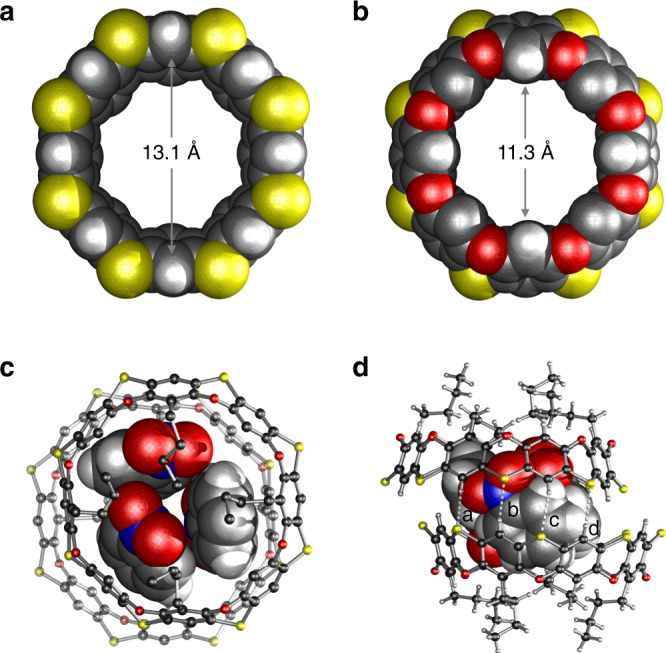
a Space-filling model view from the S rim with the four butyls omitted for clarity. b Space-filling model view from the O rim. c View of the encapsulated structure of nitrobenzenes in 1 from the top, and (d) side view of the complex with hydrogen bonds highlighted. C‒H···S hydrogen bonds: dS···H (Å), ∠C−H···S (deg), dC···S (Å) −a, 2.91, 129, 3.57; b, 3.00, 168, 3.92; c, 2.97, 165, 3.88; d, 3.03, 135, 3.75. dS···H = atomic distance between S and H, ∠C−H···S = hydrogen bond angle, dC···S = atomic distance between C and S. Color code: S = gold, O = red, N = blue, C = black, H = gray.
Fig. 4. The complexation of 1 with C60 in solution.
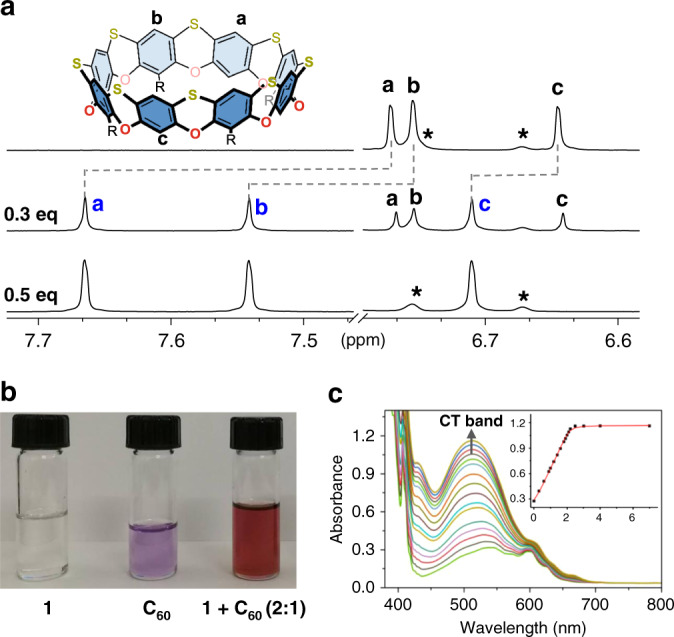
a Partial 1H NMR spectra of 1.0 mM 1 with different equivalents of fullerene C60 in o-DCB-d4 (400 MHz, 298 K). b Visualized host–guest interactions between 1 (0.6 mM) and C60 (0.3 mM) in o-DCB. c UV–vis absorption spectra of C60 upon titrating with 1 from 0 to 7 equivalents. Inset: titration curves at λ = 520 nm. *Residual peaks of deuterated solvent.
Host–guest chemistry of 1 with C60
Considering that cyclo[8]phenoxathiin 1 has a well-defined bowl-shaped cavity and donor O and S atoms on its peripheral rims, we investigated its ability to behave as a donor host for electron-deficient guests. The cavity size of 1 is comparable to [10]cycloparaphenelene29 that is an ideal host for C60; based on this observation, we presumed that 1 may have a similar binding ability toward C60. After the addition of 0.3 equivalent of C60 to 1 in o-DCB, the 1H NMR spectrum showed two sets of resonances for the protons of 1 indicating a slow-exchange complexation (Fig. 4a). Protons a and b are from the upper rim of 1 shifted downfield by 1.0 and 0.91 ppm, respectively, whereas proton c from the lower rim shifted by 0.08 ppm. Moreover, the 13C NMR spectrum of C60 in this mixture showed an upfield chemical shift from 142.6 to 140.8 ppm (Supplementary Fig. 8). Upon addition of C60 to half an equivalent of 1, the proton signal of free 1 disappeared. After addition of 7.0 equivalents of C60, no further change of the spectrum was observed (Supplementary Fig. 7), indicating a 2:1 binding stoichiometry of 1 with C60, which was further supported by MALDI-TOF-MS analysis (Supplementary Fig. 9). An intense m/z peak at 3123.14 corresponding to the C60@12 complex was observed. The weak intensity of the 1:1 complex signal in the MS analysis and the absence of the signal on the 1H NMR spectrum can be ascribed to a fast-kinetic process for the formation of the 1:1 complex30.
The complexation between 1 and C60 was further evidenced by the visual change of color and a strong charge-transfer band observed at 520 nm on the UV–Vis absorption spectra (Fig. 4b, c). By fitting the UV–Vis titration data with a 2:1 binding mode, the association constants K11 and K12 were calculated to be 1.3 × 104 M–1 and 2.8 × 105 M–1, respectively (Supplementary Fig. 10)31. A K12 ~22 times that of K11, is indicative of a positive cooperative complexation of C60 with 1. This could be explained by formation of the dimeric structure with fullerenes, which has previously been reported for other macrocycles, including peptide-derived macrocycle32, porphyrinoid33, and cyclodextrins34. The strong binding affinity (Ka = 3.6 × 109 M‒2) of 1 toward C60 enabled the isolation of the C60@12 complex directly with silica column chromatography, which could also be useful in the separation and purification of fullerene mixtures.
Single crystals of the complex C60@12 were obtained by slow diffusion of hexane into a 2:1 mixture of 1 and C60 in o-dichlorobenzene. As shown in Fig. 5a, b, C60 resides in the center of the macrocycle in a slightly offset orientation to maximize the π–π interactions with the phenylenes of 1 (centroid-to-centroid distance = 3.92 Å). As mentioned earlier, C60 is fully encapsulated in the cavity of the capsule created by the dimerization of two macrocycles through sixteen C‒H∙∙∙S hydrogen bonds from the upper rims (dS···H = 3.00 Å, ∠C−H···S = 166°, Fig. 5c, d). This dimerization accounts for the larger downfield chemical shift of protons a and b in the 1H NMR spectra and the strong binding affinity.
Fig. 5. Single-crystal X-ray structure of the complex C60@12.
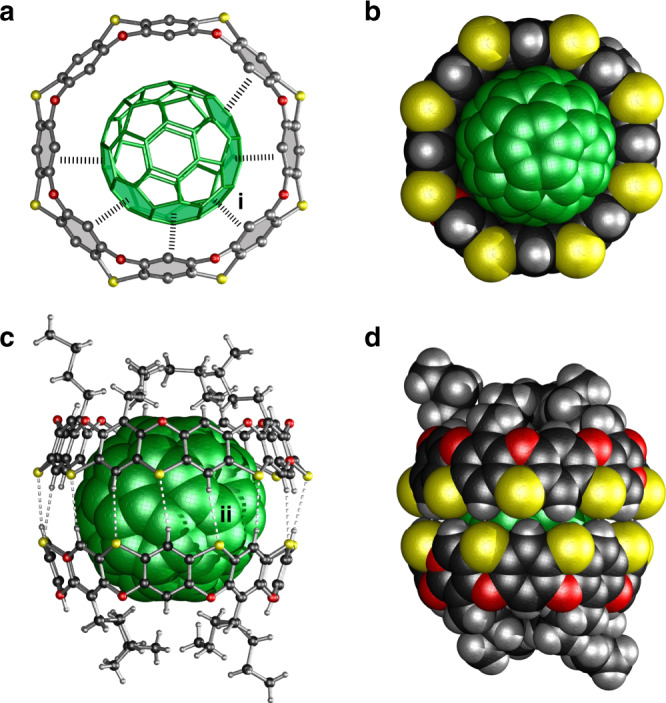
a Hemispherically binded structure with π–π interaction highlighted in bonded dash line. The representative π–π interaction i with a centroid-to-centroid distance of 3.92 Å. b Same view in space-filling model. c Fully encapsulated structures with C‒H···S hydrogen bonds highlighted in white dash lines. The representative C‒H···S hydrogen bond: dS···H (Å), ∠C−H···S (deg), dC···S (Å) −ii, 3.00, 166, 3.91. d Space-filling model representation of the dimeric structure. Color code: C60 = green, S = gold, O = red, C = black, H = gray.
Host–guest chemistry of 2 with [2,2]paracyclophane
Cyclo[8]phenoxathiin 2 was predicted to have a different conformation and cavity size because of the alternative bridging sequences of O and S atoms when compared with 1. As can be seen from Fig. 6, the 1H NMR spectrum of 2 shows four singlets in the aromatic region and two sets of methylene protons, which is consistent with C2v symmetry. The structure was further supported by the observed m/z peak at 1144.0405 from MALDI-TOF-MS analysis (Supplementary Fig. 4). Single crystals of 2 were obtained from slow diffusion of hexanes into a o-DCB solution of 2. As shown in Fig. 7a, 2 adopts an almost column-like octagon-shaped conformation with a distance of 12.1 Å from two parallel phenyl rings. Two o-DCB molecules were found to reside in the cavity of 2 to form a 1:2 complex in the solid state. One of the o-DCB molecules π-stacks with the phenylene of the wall with a centroid-to-centroid distance of 3.79 Å, while the two o-DCBs are almost parallel to each other. Based on this unique 1:2 supramolecular complex, we presumed that cyclo[8]phenoxathiin 2 may exhibit binding affinity toward the cyclic molecule [2,2]paracyclophane ([2,2]PCP), which has a similar molecular structure with two face-to-face phenylenes. The 1H NMR spectrum of an equimolar solution of 2 and [2,2]PCP in CDCl3 is shown in Supplementary Fig. 11. The signals of protons e and f from [2,2]PCP shifted upfield by 0.01 and 0.02 ppm, respectively, when compared with the free [2,2]PCP, indicating a fairly weak interaction. The changes in the chemical shift could be ascribed to the π–π interaction of [2,2]PCP with the wall of 2. An association constant of 9 M–1 was obtained by fitting the 1H NMR titration data with a 1:1 binding mode (Supplementary Figs. 12 and 13).
Fig. 6. Partial 1H NMR spectrum of 2 in chloroform-d.
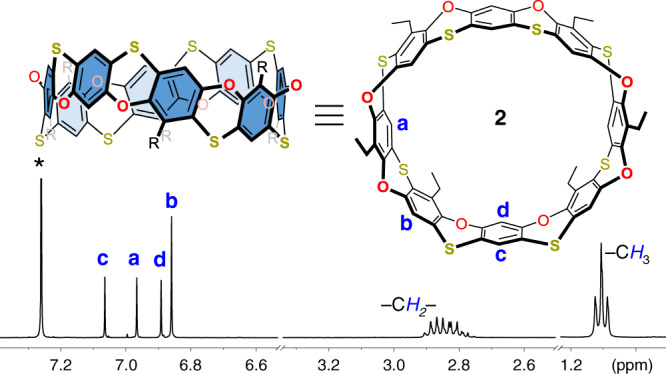
Insertion: top and side views of the structure drawing with proton labeling. The four singlets (a, b, c, and d) in the aromatic region indicate the C2v symmetry of the macrocycle. *Residual peaks of deuterated solvent.
Fig. 7. Single-crystal X-ray structures of 2 and [2,2]PCP@2.
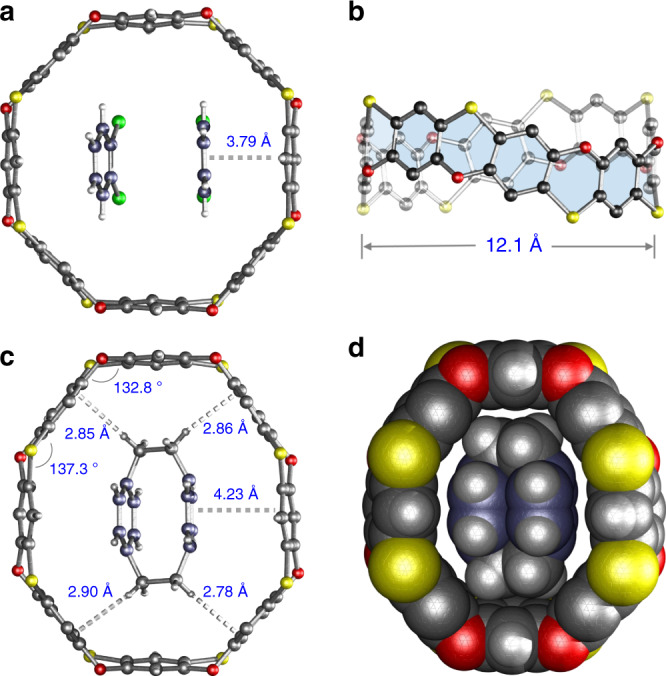
a Ball-and-stick representation of 2 with two o-DCBs in the cavity. b A view of 2 from front side showing the column-like conformation. c Ball-and-stick representation of the ring-in-ring structure of complex [2,2]PCP@2 with the CH···π and π‒π interaction highlighted in white dash lines. d Space-filling model of the ring-in-ring complex. The ethyl groups are omitted for clarity. Color code: S = gold, O = red, Cl = green, C = black or slate-blue, H = white.
Although 2 exhibits a weak binding with [2,2]PCP, single crystals of the complex were obtained by slow diffusion of diisopropyl ether into a solution of 2 and [2,2]PCP in chloroform. The guest molecule is disordered over multiple positions due to the weak binding affinity (Supplementary Fig. 15), with one of the favored conformations depicted in Fig. 7c, d. In the complex, 2 is deformed to adopt an oval-like conformation to host [2,2]PCP that results in a ring-in-ring inclusion structure35,36. One of the phenylenes of [2,2]PCP is almost parallel to the wall of 2 with a distance of 4.23 Å, indicating a weak π–π interaction. The methylene protons also showed C–H∙∙∙π interaction with the phenylenes, with an average proton to phenyl plane distance of 2.85 Å. These supramolecular interactions might be the main driving forces for formation of the ring-in-ring complex. The deformed octagonal shape of 2 upon complexation is evidence of the rigid yet dynamic nature of cyclophenoxathiin molecular belts.
Discussion
In summary, we report two novel heteroatom(O,S)-bridged belt-like macrocycles, i.e., cyclo[8]phenoxathiins. Preliminary results reveal them to have different molecular architectures and distinct host–guest chemistry. The bowl-shaped cyclo[8]phenoxathiin 1 demonstrates strong binding affinity toward fullerene C60 and forms a 2:1 capsule-like complex. By varying the bridging sequences of the S and O atoms on the two rims, we successfully obtain the other cyclo[8]phenoxathiin 2 with a column-like cavity that can bind [2,2]paracyclophane to form a ring-in-ring inclusion complex. The structural specificity and unique host–guest chemistry of this new class of belt-like macrocycles may give insights into the development of novel host–guest systems and provide further applications in supramolecular chemistry. A comprehensive study of their host–guest chemistry and other physical properties is currently ongoing.
Methods
Preparation of cyclo[8]phenoxathiins 1 and 2
Under an N2 atmosphere, a 50-mL dry round-bottom flask was charged with compound 1′ (132 mg, 0.099 mmol, 1.0 equiv) and 20 ml of trifluoromethanesulfonic acid. The reaction mixture was stirred at 80 °C for 48 h. After cooling down to room temperature, the reaction mixture was slowly poured into 80 mL of pyridine/ice water = 1/1 (V/V). The reaction mixture was stirred at 105 °C for another 15 h. After cooling down to room temperature, the excess pyridine solvent was removed under reduced pressure and filtered to get a crude product, which was purified by column chromatography on silica gel with dichloromethane/cyclohexane (v/v = 1/5) as eluent to give cyclo[8]phenoxathiin 1 (24 mg, 20% yield) as a white solid. mp > 300 °C (decomp.). 1H NMR (400 MHz, 1,1,2,2-tetrachloroethane-d2) δ 7.07 (s, 4H), 6.93 (s, 4H), 6.88 (s, 4H), 2.88 (t, J = 7.6 Hz, 8H), 1.50–1.42 (m, 16H), and 0.99 (t, J = 6.8 Hz, 12H). 13C NMR (100 MHz, 1,1,2,2-tetrachloroethane-d2) δ 153.9, 151.9, 125.6, 123.8, 122.9, 119.8, 118.7, 109.0, 32.0, 23.2, 22.5, 13.9. HRMS (m/z): [M]+ calcd. for C64H48O8S8, 1200.1109; found: 1200.1091. Cyclo[8]phenoxathiin 2 was synthesized accordingly with a yield of 16%. mp > 300 °C (decomp.). 1H NMR (400 MHz, chloroform-d) δ 7.06 (s, 2H), 6.97 (s, 2H), 6.89 (s, 2H), 6.86 (s, 4H), 2.91–2.75 (m, 12H), and 1.10 (td, J = 7.6, 1.2 Hz, 18H). 13C NMR (100 MHz, chloroform-d) δ 154.7, 152.9, 151.3, 149.4, 132.4, 126.2, 125.5, 123.6, 122.5, 120.6, 119.4, 114.9, 109.48, 21.5, 17.4, 14.9, 14.1. HRMS (m/z): [M]+ calcd. for C64H40O8S8, 1144.0483, found: 1144.0405.
Supplementary information
Acknowledgements
We thank the National Natural Science Foundation of China (21701192 and 21971268), the Program for Guangdong Introducing Innovative and Entrepreneurial Teams (2017ZT07C069), the Fundamental Research Funds for the Central Universities (19lgzd22), the Thousand Youth Talents Plan of China, and Sun Yat-Sen University for financial support. We thank Dr. Giorgio Baggi and Dr. Zhangwen Wei for assistance with X-ray single-crystal structures, Dr. V. Nicholas Vukotic, and Prof. Stephen J. Loeb from the University of Windsor for their editing comments on the paper.
Author contributions
K.Z. supervised the project and designed the experiments. J.X. and X.L. performed all the synthetic experiments and characterization. A.L. assisted in DOSY data analysis. S.W. assisted in the synthesis of compounds. J.X. collected the SCXRD data, and L.J. solved the X-ray structures. K.Z. wrote the paper with input from J.X. and X.L.
Data availability
All data generated and analyzed during this study are included in this paper and its Supplementary Information files, and are also available from the authors upon reasonable request. Atomic coordinates and structure factors for the reported crystal structures 1, C60@12, 2, and [2.2]PCP@2 have been deposited in the Cambridge Crystallographic Data Centre (www.ccdc.cam.ac.uk) under accession codes CCDC 1978840-1978843.
Competing interests
The authors declare no competing interests.
Footnotes
Peer review information Nature Communications thanks the anonymous reviewer(s) for their contribution to the peer review of this work.
Publisher’s note Springer Nature remains neutral with regard to jurisdictional claims in published maps and institutional affiliations.
These authors contributed equally: Jialin Xie, Xia Li.
Contributor Information
Long Jiang, Email: cesjl@mail.sysu.edu.cn.
Kelong Zhu, Email: zhukelong@mail.sysu.edu.cn.
Supplementary information
Supplementary information is available for this paper at 10.1038/s41467-020-17134-3.
References
- 1.Liu Z, Nalluri SKM, Stoddart JF. Surveying macrocyclic chemistry: from flexible crown ethers to rigid cyclophanes. Chem. Soc. Rev. 2017;46:2459–2478. doi: 10.1039/C7CS00185A. [DOI] [PubMed] [Google Scholar]
- 2.Böhmer V. Calixarenes, macrocycles with (almost) unlimited possibilities. Angew. Chem. Int. Ed. Engl. 1995;34:713–745. doi: 10.1002/anie.199507131. [DOI] [Google Scholar]
- 3.Ji X, Chi X, Ahmed M, Long L, Sessler JL. Soft materials constructed using Calix[4]pyrrole- and “Texas-Sized” box-based anion receptors. Acc. Chem. Res. 2019;52:1915–1927. doi: 10.1021/acs.accounts.9b00187. [DOI] [PubMed] [Google Scholar]
- 4.Timmerman P, Verboom W, Reinhoudt DN. Resorcinarenes. Tetrahedron. 1996;52:2663–2704. doi: 10.1016/0040-4020(95)00984-1. [DOI] [Google Scholar]
- 5.Xue M, Yang Y, Chi X, Zhang Z, Huang F. Pillararenes, a new class of macrocycles for supramolecular chemistry. Acc. Chem. Res. 2012;45:1294–1308. doi: 10.1021/ar2003418. [DOI] [PubMed] [Google Scholar]
- 6.Wang M. Coronarenes: recent advances and perspectives on macrocyclic and supramolecular chemistry. Sci. China Chem. 2018;61:993–1003. doi: 10.1007/s11426-018-9328-8. [DOI] [Google Scholar]
- 7.Dale EJ, et al. Supramolecular explorations: exhibiting the extent of extended cationic cyclophanes. Acc. Chem. Res. 2016;49:262–273. doi: 10.1021/acs.accounts.5b00495. [DOI] [PubMed] [Google Scholar]
- 8.Leonhardt EJ, Jasti R. Emerging applications of carbon nanohoops. Nat. Rev. Chem. 2019;3:672–686. doi: 10.1038/s41570-019-0140-0. [DOI] [Google Scholar]
- 9.Geng W, et al. A noncovalent fluorescence turned-on strategy for hypoxia imaging. Angew. Chem. Int. Ed. 2019;58:2377–2381. doi: 10.1002/anie.201813397. [DOI] [PubMed] [Google Scholar]
- 10.Wu J, Yang Y. Geminiarene: molecular scale dual selectivity for chlorobenzene and chlorocyclohexane fractionation. J. Am. Chem. Soc. 2019;141:12280–12287. doi: 10.1021/jacs.9b03559. [DOI] [PubMed] [Google Scholar]
- 11.Xu Z, et al. Heteromultivalent peptide recognition by co-assembly of cyclodextrin and calixarene amphiphiles enables inhibition of amyloid fibrillation. Nat. Chem. 2019;11:86–93. doi: 10.1038/s41557-018-0164-y. [DOI] [PubMed] [Google Scholar]
- 12.Leigh DA. Genesis of the nanomachines: the 2016 nobel prize in chemistry. Angew. Chem. Int. Ed. 2016;55:14506–14508. doi: 10.1002/anie.201609841. [DOI] [PubMed] [Google Scholar]
- 13.Gleiter R, Esser B, Kornmayer SC. Cyclacenes: hoop-shaped systems composed of conjugated rings. Acc. Chem. Res. 2009;42:1108–1116. doi: 10.1021/ar9000179. [DOI] [PubMed] [Google Scholar]
- 14.Nishigaki S, et al. Synthesis of belt- and möbius-shaped cycloparaphenylenes by rhodium-catalyzed alkyne cyclotrimerization. J. Am. Chem. Soc. 2019;141:14955–14960. doi: 10.1021/jacs.9b06197. [DOI] [PubMed] [Google Scholar]
- 15.Povie G, et al. Synthesis of a carbon nanobelt. Science. 2017;356:172–175. doi: 10.1126/science.aam8158. [DOI] [PubMed] [Google Scholar]
- 16.Cram DJ. Cavitands: organic hosts with enforced cavities. Science. 1983;219:1177–1183. doi: 10.1126/science.219.4589.1177. [DOI] [PubMed] [Google Scholar]
- 17.Eisenberg D, Shenhara R, Rabinovitz M. Synthetic approaches to aromatic belts: building up strain in macrocyclic polyarenes. Chem. Soc. Rev. 2010;39:2879–2890. doi: 10.1039/b904087k. [DOI] [PubMed] [Google Scholar]
- 18.Myśliwiec D, Stępień M. The fold-in approach to bowl-shaped aromatic compounds: synthesis of chrysaoroles. Angew. Chem. Int. Ed. 2013;52:1713–1717. doi: 10.1002/anie.201208547. [DOI] [PubMed] [Google Scholar]
- 19.Zhang Q, Zhang Y, Tong S, Wang M. Hydrocarbon belts with truncated cone structures. J. Am. Chem. Soc. 2020;142:1196–1199. doi: 10.1021/jacs.9b12181. [DOI] [PubMed] [Google Scholar]
- 20.Kornmayer SC, Esser B, Gleiter R. DFT calculations on heterocyclacenes. Org. Lett. 2009;11:725–728. doi: 10.1021/ol8028115. [DOI] [PubMed] [Google Scholar]
- 21.Leuninger J, et al. Novel approach to ladder-type polymers: polydithiathianthrene via the intramolecular acid-induced cyclization of methylsulfinyl-substituted poly(meta-phenylene sulfide) Macromol. Chem. Phys. 2001;202:2832–2842. doi: 10.1002/1521-3935(20011001)202:14<2832::AID-MACP2832>3.0.CO;2-V. [DOI] [Google Scholar]
- 22.Wang J, Miao Q. A tetraazapentacene–pyrene belt: toward synthesis of N-doped zigzag carbon nanobelts. Org. Lett. 2019;21:10120–10124. doi: 10.1021/acs.orglett.9b04116. [DOI] [PubMed] [Google Scholar]
- 23.Oyaizu K, et al. Synthetic routes to polyheteroacenes: characterization of a heterocyclic ladder polymer containing phenoxathiinium-type building blocks. Macromolecules. 2002;35:67–78. doi: 10.1021/ma010961d. [DOI] [Google Scholar]
- 24.El-karim IAG. Quantum mechanical calculations on phenoxathiin and azaphenoxathiins heterocycles. J. Mol. Struct.: THEOCHEM. 2005;723:223–230. doi: 10.1016/j.theochem.2005.02.023. [DOI] [Google Scholar]
- 25.Maesa W, Dehaen W. Oxacalix[n](het)arenes. Chem. Soc. Rev. 2008;37:2393–2402. doi: 10.1039/b718356a. [DOI] [PubMed] [Google Scholar]
- 26.Landovský T, et al. Regioselective SNAr reaction of the phenoxathiin-based thiacalixarene as a route to a novel macrocyclic skeleton. Chem. Commun. 2020;56:78–81. doi: 10.1039/C9CC08335A. [DOI] [PubMed] [Google Scholar]
- 27.Johnson CS., Jr. Diffusion ordered nuclear magnetic resonance spectroscopy: principles and applications. Prog. Nucl. Magn. Reson. Spectrosc. 1999;34:203–256. doi: 10.1016/S0079-6565(99)00003-5. [DOI] [Google Scholar]
- 28.Gibb CLD, Gibb BC. Well-defined, organic nanoenvironments in water: the hydrophobic effect drives a capsular assembly. J. Am. Chem. Soc. 2004;126:11408–11409. doi: 10.1021/ja0475611. [DOI] [PubMed] [Google Scholar]
- 29.Xia J, Bacona JW, Jasti R. Gram-scale synthesis and crystal structures of [8]- and [10]CPP, and the solid-state structure of C60@[10]CPP. Chem. Sci. 2012;3:3018–3021. doi: 10.1039/c2sc20719b. [DOI] [Google Scholar]
- 30.Tang H, et al. Dynamics of a supramolecular capsule assembly with pyrene. J. Am. Chem. Soc. 2012;134:5544–5547. doi: 10.1021/ja301278p. [DOI] [PMC free article] [PubMed] [Google Scholar]
- 31.Thordarson P, et al. Thordarson, P. Determining association constants from titration experiments in supramolecular chemistry. Chem. Soc. Rev. 2011;40:1305–1323. doi: 10.1039/C0CS00062K. [DOI] [PubMed] [Google Scholar]
- 32.Huerta E, et al. Selective binding and easy separation of C70 by nanoscale self-assembled capsules. Angew. Chem. Int. Ed. 2007;46:202–205. doi: 10.1002/anie.200603223. [DOI] [PubMed] [Google Scholar]
- 33.Ke X, et al. Expanded rosarin: a versatile fullerene (C60) receptor. J. Am. Chem. Soc. 2017;139:4627–4630. doi: 10.1021/jacs.7b00735. [DOI] [PubMed] [Google Scholar]
- 34.Ikeda A, et al. Pseudorotaxane structure of a fullerene derivative-cyclodextrin 1: 2 complex. Chem. Commun. 2011;47:12795–12797. doi: 10.1039/c1cc15229g. [DOI] [PubMed] [Google Scholar]
- 35.Kim S, et al. Macrocycles within macrocycles: cyclen, cyclam, and their transition metal complexes encapsulated in cucurbit[8]uril. Angew. Chem. Int. Ed. 2001;40:2119–2121. doi: 10.1002/1521-3773(20010601)40:11<2119::AID-ANIE2119>3.0.CO;2-4. [DOI] [PubMed] [Google Scholar]
- 36.Iwanaga T, et al. Cyclophanes within cyclophanes: the synthesis of a pyromellitic diimide-based macrocycle as a structural unit in a molecular tube and its inclusion phenomena. Angew. Chem. Int. Ed. 2006;45:3643–3647. doi: 10.1002/anie.200504499. [DOI] [PubMed] [Google Scholar]
Associated Data
This section collects any data citations, data availability statements, or supplementary materials included in this article.
Supplementary Materials
Data Availability Statement
All data generated and analyzed during this study are included in this paper and its Supplementary Information files, and are also available from the authors upon reasonable request. Atomic coordinates and structure factors for the reported crystal structures 1, C60@12, 2, and [2.2]PCP@2 have been deposited in the Cambridge Crystallographic Data Centre (www.ccdc.cam.ac.uk) under accession codes CCDC 1978840-1978843.



